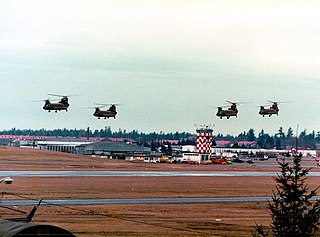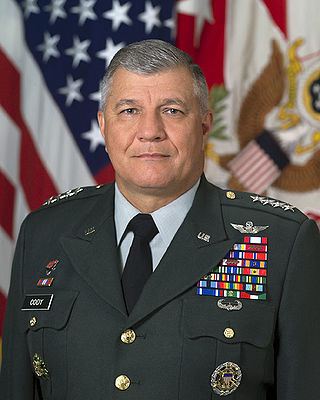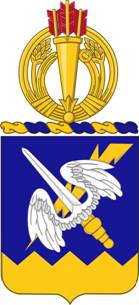
The 101st Airborne Division (Air Assault) ("Screaming Eagles") is a light infantry division of the United States Army that specializes in air assault operations. It can plan, coordinate, and execute multiple battalion-size air assault operations to seize terrain. These operations can be conducted by mobile teams covering large distances, fighting behind enemy lines, and working in austere environments with limited or degraded infrastructure. It was active in, for example, foreign internal defense and counterterrorism operations in Iraq, in Afghanistan in 2015–2016, and in Syria, as part of Operation Inherent Resolve in 2018–2021.

The 160th Special Operations Aviation Regiment (Airborne), abbreviated as 160th SOAR (A), is a special operations force of the United States Army that provides helicopter aviation support for special operations forces. Its missions have included attack, assault, and reconnaissance, and these missions are usually conducted at night, at high speeds, low altitudes, and on short notice.

The United States Army Special Operations Command (Airborne) (USASOC ( YOO-sə-sok)) is the command charged with overseeing the various special operations forces of the United States Army. Headquartered at Fort Liberty, North Carolina, it is the largest component of the United States Special Operations Command. It is an Army Service Component Command. Its mission is to organize, train, educate, man, equip, fund, administer, mobilize, deploy and sustain Army special operations forces to successfully conduct worldwide special operations.
Fort Campbell is a United States Army installation located astride the Kentucky–Tennessee border between Hopkinsville, Kentucky and Clarksville, Tennessee. Fort Campbell is home to the 101st Airborne Division and the 160th Special Operations Aviation Regiment. The fort is named in honor of Union Army Brigadier General William Bowen Campbell, the last Whig Governor of Tennessee.

Gray Army Airfield, also known as Gray AAF, is a military airfield located within Joint Base Lewis–McChord near Tacoma, in Pierce County, Washington, United States.
The United States Army Regimental System (USARS) is an organizational and classification system used by the United States Army. It was established in 1981 to replace the Combat Arms Regimental System (CARS) to provide each soldier with continuous identification with a single regiment, and to increase a soldier's probability of serving recurring assignments with his or her regiment. The USARS was intended to enhance combat effectiveness by providing the opportunity for a regimental affiliation, thus obtaining some of the benefits of the traditional regimental system.

The Oklahoma Army National Guard is the Army National Guard component of the Oklahoma National Guard. The Commander in Chief of the Oklahoma National Guard is the Governor of Oklahoma, who appoints the State Adjutant General (TAG), a Major General from either Army or Air. Currently, the TAG is Brig. Gen. Thomas H. Mancino. The previous TAG was Maj. Gen. Michael Thompson.

Richard Arthur "Dick" Cody is a retired United States Army general who served as the 31st Vice Chief of Staff of the United States Army from June 24, 2004, to July 31, 2008. He retired from the Army on August 1, 2008.

The 158th Aviation Regiment is an aviation regiment of the United States Army.
The 229th Aviation Regiment is an aviation unit of the United States Army.

The 12th Combat Aviation Brigade is a Combat Aviation Brigade of the United States Army. It was first organized as the 12th Aviation Group at Fort Moore, Georgia, on 18 June 1965.

In the United States (US) military, a beret flash is a shield-shaped embroidered cloth that is typically 2.25 in (5.72 cm) tall and 1.875 in (4.76 cm) wide with a semi–circular base that is attached to a stiffener backing of a military beret. These flashes—a British English word for a colorful cloth patch attached to military headgear—are worn over the left eye with the excess cloth of the beret shaped, folded, and pulled over the right ear giving it a distinctive appearance.
In 2009, the United States and NATO International Security Assistance Force (ISAF) coalition, along with Afghan National Army forces, continued military operations against the Taliban in Afghanistan. 2009 marks the eighth year of the War in Afghanistan, which began late in 2001. And 75th ranger regiment is also in Afghanistan as of 2018

Simmons Army Airfield is a military use airport located in Cumberland County, North Carolina, United States. It is located on the southeast portion of Fort Liberty and supports the aviation needs of the XVIII Airborne Corps, the 82nd Airborne Division, Special Operations, U.S. Army Reserve and U.S. National Guard aviation units.

The Combat Aviation Brigade, 101st Airborne Division is a Combat Aviation Brigade (CAB) of the United States Army. It was first organized in July 1968 as an aviation group and stands as the most decorated aviation unit in the United States Army. It was redesignated an aviation brigade in 1986. It has served in almost every single military operation since the Vietnam War. In support of the Global War on Terror, the CAB has distinguished itself as the military's premiere combat aviation unit during its two deployments to Iraq and five deployments to Afghanistan. The brigade has flown hundreds of thousands of hours during these combat tours, transporting millions of troops around the battlefield and providing close air support/aerial reconnaissance. The 101st broke its own record for longest air assault in history during the invasion of Iraq in 2003. Previously, the longest air assault was conducted in 1991 during Operation Desert Storm.

The 3rd Aviation Regiment is a regiment of the United States Army Aviation Branch. It operates the Boeing AH-64 Apache attack helicopter, Sikorsky UH-60 Black Hawk helicopter, and Boeing CH-47 Chinook helicopter. It has been associated with the 3rd Infantry Division for some time.

The 101st Aviation Regiment is an aviation regiment of the U.S. Army.

Forward Operating Base Shank is a former Forward operating base of the U.S. military, located in Logar Province of eastern Afghanistan, about 12 km south-east of the city of Baraki Barak. During Operation Enduring freedom, FOB Shank was one of the most heavily rocketed forward operating bases in Afghanistan. In 2014, the base was turned over to Afghan National Army, who established Camp Maiwand at the northern end of the FOB. American forces later returned and reoccupied the southern portion of the FOB, under the name Camp Dahlke.

Forward Operating Base (FOB) Fenty was a military base built around Jalalabad Airport.

The United States Army Special Operations Aviation Command (USASOAC) provides command and control, executive oversight, and resourcing of U.S. Army Special Operations Command (USASOC) aviation assets and units in support of national security objectives. USASOAC is responsible for service and component interface; training, doctrine, and proponency for Army Special Operations Aviation (SOA); system integration and fleet modernization; aviation resource management; material readiness; program management; and ASCC oversight. USASOAC was established 25 March 2011 consisting of 135 headquarters soldiers and subordinate units totaling more than 3,300 personnel, include the 160th Special Operations Aviation Regiment (Airborne), (160th SOAR (A)) which features 4 Aviation Battalions, the USASOC Flight Company, the Special Operations Aviation Training Battalion, the Systems Integration Management Office, and the Technology Application Projects Office. The first commander of USASOAC was Brig Gen. Kevin Mangum.
 101st Airborne Division
101st Airborne Division 
 Brigade Headquarters and Headquarters Company ("Hell Cats")
Brigade Headquarters and Headquarters Company ("Hell Cats")
 2nd Squadron, 17th Cavalry Regiment ("Out Front")
2nd Squadron, 17th Cavalry Regiment ("Out Front")
 1st Battalion, 101st Aviation Regiment ("Expect No Mercy")
1st Battalion, 101st Aviation Regiment ("Expect No Mercy")
 5th Battalion, 101st Aviation Regiment ("Eagle Assault")
5th Battalion, 101st Aviation Regiment ("Eagle Assault")
 6th Battalion, 101st Aviation Regiment (General Support) ("Shadow of the Eagle")
6th Battalion, 101st Aviation Regiment (General Support) ("Shadow of the Eagle")
 96th Aviation Support Battalion ("Troubleshooters")
96th Aviation Support Battalion ("Troubleshooters") 160th Special Operations Aviation Regiment (Airborne)
160th Special Operations Aviation Regiment (Airborne) 













